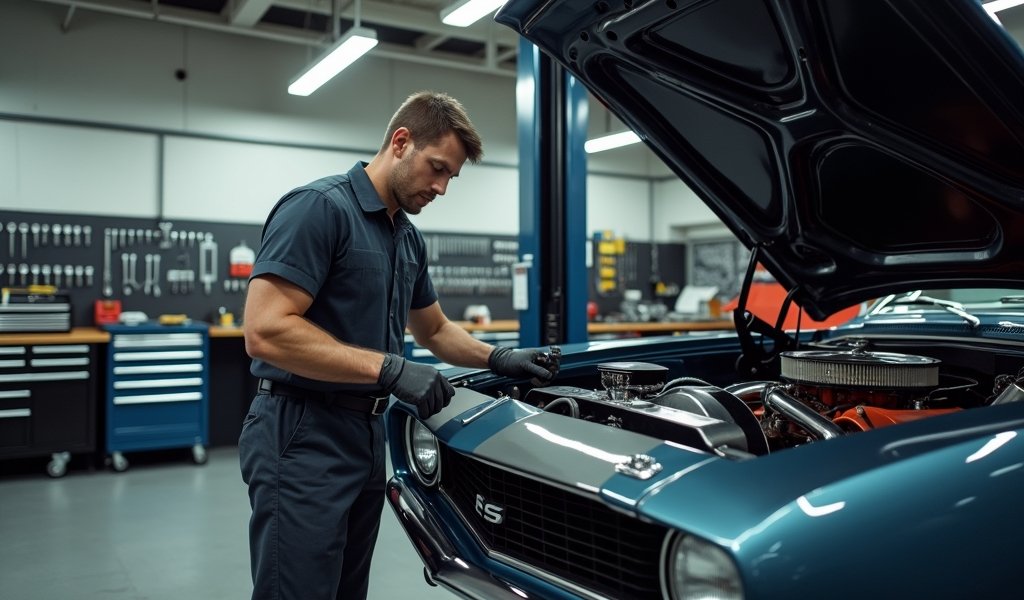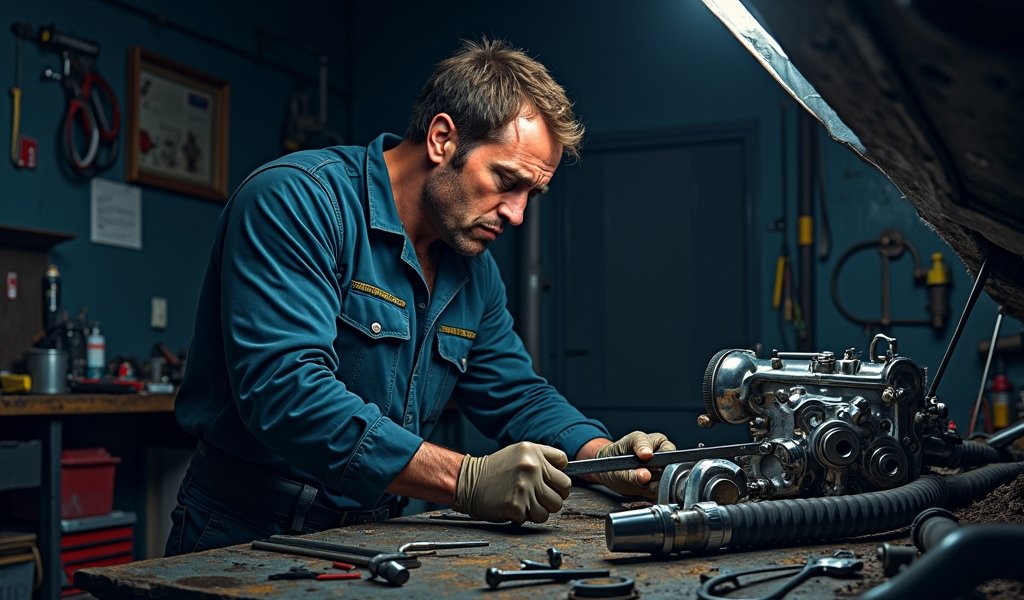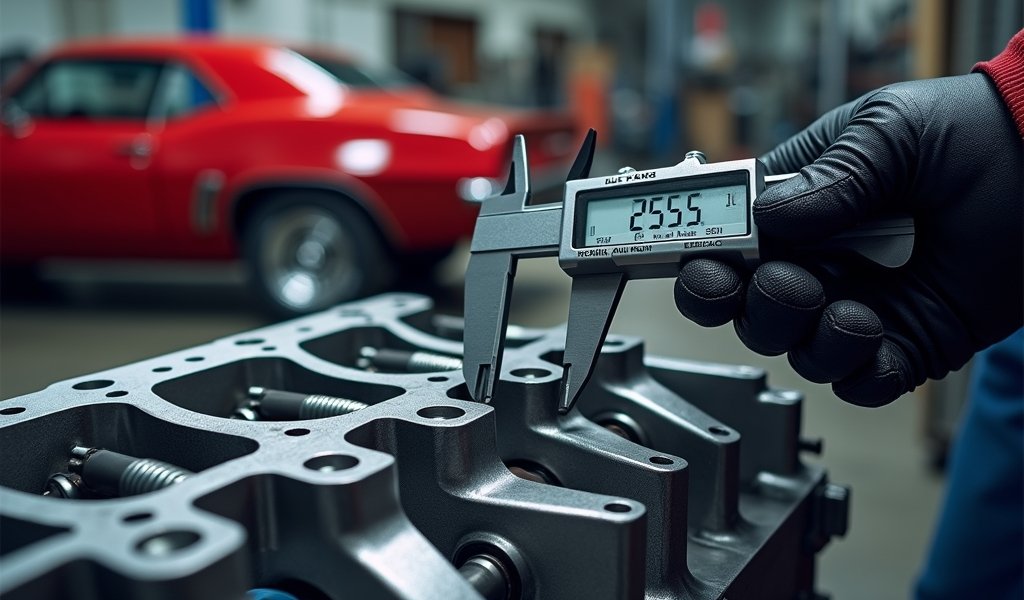Overview
This article explains how proper pushrod length is critical for engine performance, detailing measurement techniques with specialized tools and highlighting how incorrect length can cause valve train issues, reduced power, and premature component wear. It provides step-by-step measurement guidance, discusses variables affecting pushrod length (including camshaft profiles and head milling), and emphasizes fine-tuning for optimal engine performance through precise measurements accurate to within 0.001″.
Table of Contents
- Why Pushrod Length Matters
- Understanding Pushrod Basics
- Essential Measuring Tools for Accurate Results
- Proper Measurement Technique: Step-by-Step Guide
- Accounting for All Variables in Your Engine Build
- Fine-Tuning for Optimal Performance
- Conclusion
- Frequently Asked Questions
Why Pushrod Length Matters
Those little metal rods in your engine might not look like much, but believe me, they’re the unsung heroes of your valve train. After 25 years under the hood, I’ve seen firsthand how proper pushrod length measurement can transform an engine from a rough-running headache into a smooth-operating powerhouse.
Pushrods are the critical connection between your lifters and rocker arms, translating camshaft motion into the precise valve movements that keep your engine breathing properly. Get the length wrong, even by a few thousandths of an inch, and you’re looking at a cascade of problems that can plague performance and eventually lead to expensive failures.
I’ve rebuilt engines where improper pushrod length was causing mysterious power loss, unusual valve train noise, and excessive component wear. The owners had already replaced numerous parts trying to fix these issues, when all along, it was those humble pushrods that needed attention.
Understanding Pushrod Basics
Before we dive into measurement techniques, let’s understand what we’re actually trying to achieve. The perfect pushrod length creates ideal geometry between your valve train components, allowing the rocker arm to pivot correctly across the valve tip with minimal side loading.
When pushrods are too short, the rocker arm contact point shifts toward the pushrod side of the valve, creating excessive side thrust. This is like trying to push a door open from the hinged side—inefficient and damaging. You’ll notice premature valve guide wear, potential valve stem bending, and reduced valve lift.
Conversely, pushrods that are too long shift contact toward the opposite side of the valve stem. This not only causes similar wear issues but can also affect valve timing events and create clearance problems. In hydraulic lifter applications, overly long pushrods can prevent the lifter from maintaining proper preload.
Here’s what improper pushrod length typically causes:
- Accelerated valve guide and valve stem wear
- Premature camshaft lobe and lifter failure
- Inconsistent valve timing across cylinders
- Reduced power output (especially at higher RPMs)
- Persistent valve train noise that defies normal diagnosis

Essential Measuring Tools for Accurate Results
You wouldn’t try to time a dragster with a sundial, and similarly, you shouldn’t attempt pushrod measurement without the right tools. From my toolbox to yours, here are the instruments that make the job both possible and precise.
The foundation of accurate measurement is an adjustable checking pushrod. This clever device can be set to various lengths and locked in place, allowing you to determine the exact length needed before ordering custom pushrods. For the weekend mechanic, basic models in the $30-60 range will get the job done.
Once you’ve set your checking pushrod, you’ll need to measure it accurately. For this, I recommend:
- A quality micrometer with range appropriate for your engine ($50-100)
- Digital calipers as a backup measuring tool ($25-60)
- A machinist’s rule for quick reference checks
For those building high-performance engines where precision is paramount, consider investing in a dedicated pushrod length micrometer. These specialized tools make the job faster and often more accurate, eliminating the need to transfer measurements between tools.
According to Engine Builder Magazine, professional engine builders recommend measuring tools with accuracy to within 0.001″ for proper pushrod fitting. This level of precision is necessary because even small variations can be magnified through the rocker arm ratio.
Proper Measurement Technique: Step-by-Step Guide
Now let’s get our hands dirty with the actual measurement process. I’ve refined this technique over thousands of engines, and it consistently delivers accurate results. Follow these steps carefully, and you’ll nail the perfect pushrod length every time.
First, assemble your engine with all components that affect geometry except the actual pushrods. This includes:
- Camshaft (installed and timed correctly)
- Lifters (seated in their bores)
- Cylinder heads (torqued to final specifications)
- Valves, springs, and retainers (installed)
- Rocker arms (mounted but not tightened down)
Next, rotate the engine until the lifter for the cylinder you’re measuring is sitting on the base circle of the cam (valve fully closed). This position gives you the true geometric relationship when the valve is closed.
Insert your adjustable checking pushrod between the lifter and rocker arm. Adjust the rocker arm until it contacts the valve tip correctly—the rocker arm roller or face should be positioned properly over the valve stem tip. This is the “sweet spot” where the rocker geometry works as designed.
Lock your checking pushrod at this length and carefully remove it. Measure the locked checking pushrod with your micrometer or caliper, being careful not to disturb its setting.
I always recommend measuring at least two cylinders on each bank of a V-configuration engine. While they should theoretically be identical, manufacturing variations can sometimes require different pushrod lengths for optimal performance.
For hydraulic lifter applications, there’s an additional consideration: preload. You’ll want to adjust the pushrod length to achieve the manufacturer’s recommended lifter preload, typically 0.020-0.040″ for most street applications. Engine Labs explains that proper preload ensures the lifter operates within its designed range, preventing valve train instability at higher RPMs.
Accounting for All Variables in Your Engine Build
Here’s where many amateur engine builders go wrong—they fail to consider how component changes affect pushrod length requirements. Think of it as a complex equation where changing any variable necessitates recalculating the result.
Camshaft profiles significantly impact required pushrod length. A higher-lift camshaft generally requires a different pushrod length than a milder cam due to the changed relationship between the base circle and the lobe. When upgrading your camshaft, always remeasure your pushrod requirements.
Head milling is another common variable. For every 0.010″ removed from the cylinder head deck surface, you’ll typically need approximately 0.015-0.020″ longer pushrods to compensate. This isn’t a direct 1:1 relationship due to the angles involved in the rocker arm movement.
Changing your rocker arm ratio? That’s another reason to remeasure. Going from stock 1.5:1 rockers to performance 1.7:1 rockers changes the geometry significantly. Higher ratio rockers also magnify any pushrod length errors, making precise measurement even more critical.
Even switching to a different brand of lifters can affect the required pushrod length, as lifter heights can vary slightly between manufacturers. When I’m building a performance engine, I measure pushrod length with the exact components that will be used in the final assembly.
Don’t forget the often-overlooked variable of operating temperature. Metals expand when heated, and different components expand at different rates. For critical applications, some engine builders perform final checks with components heated to simulate operating temperatures.

Fine-Tuning for Optimal Performance
Getting the pushrod length technically correct is just the starting point. For maximum performance, a bit of fine-tuning can yield impressive results. This is where engine building becomes as much art as science.
In my experience, experimenting with pushrod lengths in 0.025″ increments can reveal interesting performance characteristics. I’ve worked on engines where slightly longer pushrods (within 0.050″ of the measured “correct” length) improved high-RPM performance by altering the valve timing events slightly.
For hydraulic lifter setups, the sweet spot typically provides 0.020-0.040″ of lifter preload when hot. Too little preload can cause the lifter to “pump up” too quickly, potentially affecting valve timing. Too much preload can prevent the lifter from maintaining proper contact, leading to valve train noise and potential damage.
With solid lifter applications, pushrod length directly affects valve lash. Getting this right is crucial for both performance and reliability. According to Hot Rod Magazine, precise valve lash is particularly important with aggressive cam profiles, where the margin for error is much smaller than with mild street cams.
Listen to your engine—it communicates through performance and sound. Valve train noise that appears at specific RPM ranges often indicates geometry issues that can be resolved with pushrod length adjustments. A healthy valve train should operate without excessive noise throughout the RPM range.
For the ultimate in fine-tuning, some professional builders use specialized equipment to monitor valve motion directly. While this is beyond the scope of most DIY builders, understanding that valve motion can be optimized through pushrod length gives you insight into why this seemingly simple component is so critical to performance.
Conclusion
Proper pushrod length measurement might seem like a small detail in the grand scheme of engine building, but it’s one of those critical factors that separates mediocre builds from exceptional ones. The time you invest in getting this right pays dividends in performance, reliability, and engine longevity.
Remember that pushrod length isn’t just about preventing problems—it’s about optimizing how your engine breathes. When your valve train geometry is spot-on, valves open and close exactly as the camshaft designer intended, allowing your engine to reach its full potential.
I’ve seen countless engines transformed from rough-running disappointments to smooth, powerful performers simply by correcting pushrod length issues. It’s a detail that many overlook, but one that true engine building professionals never neglect.
Take your time with this process, invest in quality measuring tools, and follow the techniques outlined in this guide. Your engine will thank you with crisp throttle response, smooth operation, and the sweet sound of properly orchestrated mechanical symphony under the hood.
Frequently Asked Questions
What happens if my pushrods are too short?
Short pushrods cause the rocker arm to contact the valve stem incorrectly, creating excessive side loading and accelerated wear. This typically leads to valve guide wear, reduced valve lift, and potential valve stem bending.
How accurate do my measurements need to be for pushrod length?
For most applications, measurements should be accurate to within 0.001″ (one thousandth of an inch). Higher-performance engines with aggressive cam profiles and higher rocker ratios may require even greater precision.
Do I need to measure pushrod length for every cylinder?
While measuring every cylinder is ideal, at minimum you should measure at least two cylinders on each bank of a V-configuration engine. Manufacturing variations can sometimes require different pushrod lengths for optimal performance across cylinders.
Can I reuse my old pushrods when upgrading other components?
Generally, no. Any changes to heads, camshaft, lifters, or rocker arms will likely require different pushrod lengths. Always remeasure when making component changes.
How often should pushrod length be checked during an engine’s life?
Pushrod length should be checked during initial assembly and whenever valve train components are replaced or modified. In a properly built engine that isn’t modified, the original measurements should remain valid throughout its service life.

